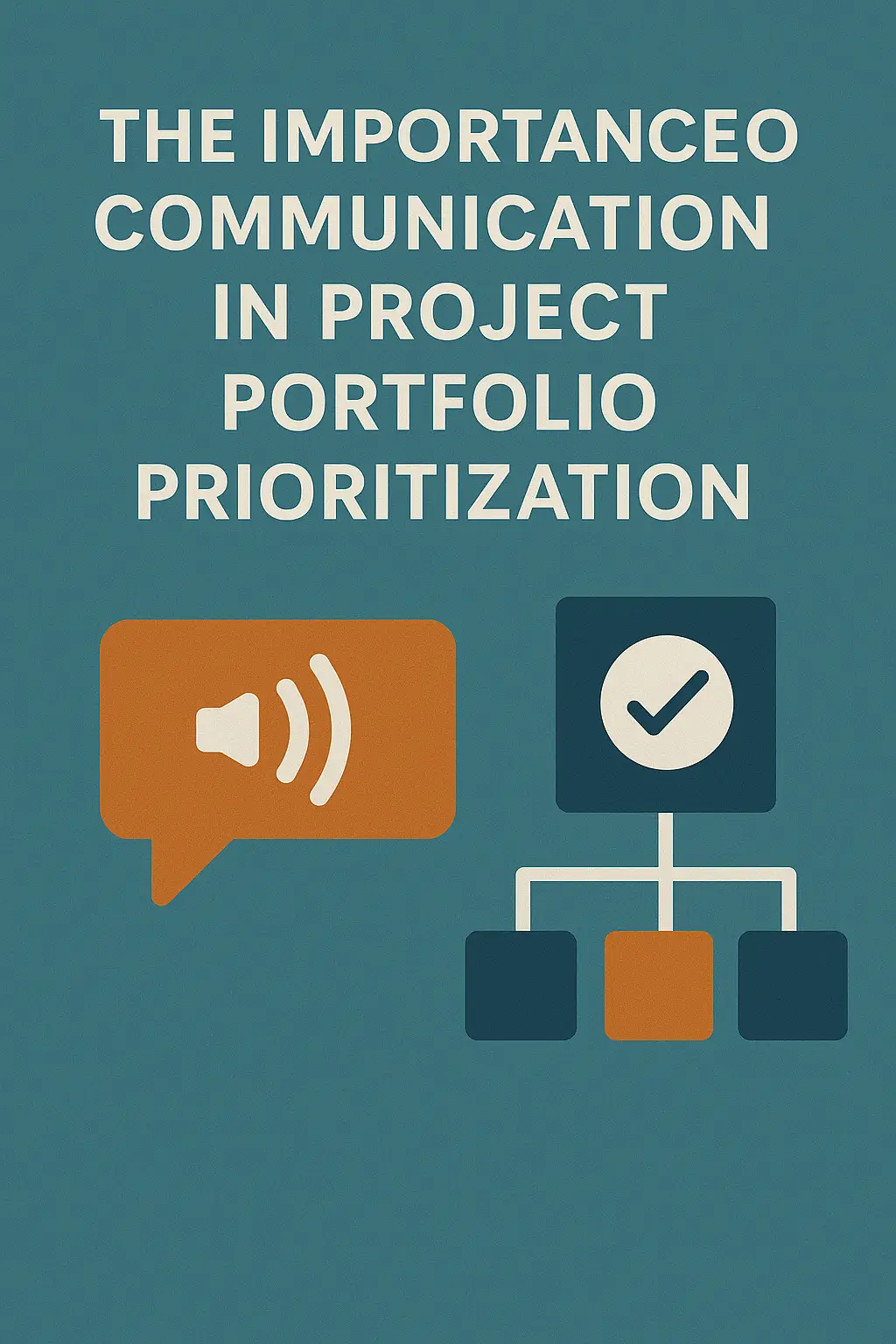Introduction
Project portfolio prioritization is a critical process that involves selecting and ranking projects based on their alignment with strategic goals and resource availability. This practice ensures that organizations focus their efforts on initiatives that deliver the most value, thereby optimizing resource allocation and enhancing overall project success. By systematically evaluating projects, teams can make informed decisions that align with their strategic objectives, ultimately leading to improved performance and outcomes.
The relevance of prioritization in project management cannot be overstated. It serves as a guiding framework that helps project teams navigate the complexities of multiple initiatives. Effective prioritization allows organizations to:
- Improve Strategic Alignment: By assessing projects against strategic goals, teams can eliminate those that do not contribute to the organization’s objectives, ensuring that resources are directed towards initiatives that matter most [2].
- Reduce Resource Waste: A portfolio view enables teams to identify and mitigate resource waste, ensuring that time, money, and personnel are utilized efficiently [2].
- Enhance Risk Management: Prioritization facilitates a better understanding of the risk profiles associated with different projects, allowing organizations to diversify their portfolios and manage potential uncertainties effectively [10].
However, the success of project portfolio prioritization hinges significantly on effective communication. Clear and open lines of communication among project teams, stakeholders, and leadership are essential for several reasons:
- Clarity in Decision-Making: Effective communication ensures that all team members understand the criteria and rationale behind project prioritization decisions. This clarity fosters a shared understanding and alignment among team members, which is crucial for successful implementation [3].
- Stakeholder Engagement: Engaging stakeholders early and maintaining ongoing communication throughout the prioritization process helps to build trust and buy-in. When stakeholders feel heard and involved, they are more likely to support the prioritization outcomes, leading to smoother project execution [9].
- Facilitating Collaboration: Communication enhances collaboration among team members, enabling them to share insights, address concerns, and collectively refine prioritization efforts. This collaborative approach can lead to more robust decision-making and a stronger commitment to the chosen projects [4].
Project portfolio prioritization is a vital aspect of project management that ensures organizations focus on the right initiatives. By leveraging effective communication, project teams can enhance clarity, foster stakeholder buy-in, and ultimately drive the success of their projects.
Understanding Project Portfolio Prioritization
Project portfolio prioritization is a critical aspect of project management that ensures resources are allocated effectively to the most valuable projects. This process not only enhances the likelihood of project success but also aligns project outcomes with the strategic objectives of the organization. Effective communication plays a vital role in this process, fostering clarity and buy-in among project teams and stakeholders.
Factors Influencing Prioritization Decisions
Several factors influence prioritization decisions in project portfolio management:
- Strategic Alignment: Projects must align with the organization’s strategic goals. This alignment helps in assessing which projects contribute to the overall mission and vision of the organization, ensuring that resources are directed towards initiatives that drive value [3][10].
- Resource Availability: The availability of resources, including budget, personnel, and technology, significantly impacts prioritization. Projects that require resources that are scarce or over-committed may be deprioritized in favor of those that can be executed with available resources [8][14].
- Risk Assessment: Understanding the risks associated with each project is crucial. Projects with higher potential returns but also higher risks may require more thorough evaluation and discussion among stakeholders to determine their prioritization [5][12].
- Stakeholder Input: Engaging stakeholders in the prioritization process ensures that diverse perspectives are considered. This can lead to more informed decisions and greater buy-in from those involved in project execution [6][11].
Common Prioritization Frameworks and Methodologies
There are several frameworks and methodologies that organizations can adopt for effective project portfolio prioritization:
- Weighted Scoring Model: This method involves assigning weights to various criteria (such as strategic alignment, cost, and risk) and scoring each project against these criteria. The total score helps in ranking projects based on their overall value [10][12].
- MoSCoW Method: This framework categorizes projects into four groups: Must have, Should have, Could have, and Won’t have. This helps teams focus on essential projects while still considering other initiatives that may be beneficial [12][15].
- Cost-Benefit Analysis: This approach evaluates the expected benefits of a project against its costs. Projects that offer a higher return on investment are prioritized, ensuring that the organization maximizes its resource utilization [10][14].
- Kano Model: This model helps prioritize projects based on customer satisfaction and the features that will delight users. It encourages teams to focus on projects that enhance customer experience and satisfaction [12][15].
Importance of Aligning Projects with Organizational Goals
Aligning projects with organizational goals is paramount for several reasons:
- Enhanced Strategic Focus: When projects are aligned with strategic objectives, organizations can ensure that all efforts contribute to overarching goals, leading to improved performance and outcomes [3][10].
- Resource Optimization: By prioritizing projects that align with strategic goals, organizations can optimize resource allocation, reducing waste and ensuring that investments yield the highest possible returns [3][8].
- Increased Stakeholder Engagement: Clear communication about how projects align with organizational goals fosters greater engagement and buy-in from stakeholders. When team members understand the importance of their work in the context of broader objectives, they are more likely to be motivated and committed to project success [6][11].
Effective communication is essential in project portfolio prioritization. It not only clarifies the decision-making process but also ensures that all team members and stakeholders are aligned and engaged in achieving the organization’s strategic goals. By understanding the factors influencing prioritization, utilizing established frameworks, and emphasizing alignment with organizational objectives, project teams can enhance their prioritization efforts and drive successful project outcomes.
The Role of Communication in Prioritization
Effective communication is a cornerstone of successful project portfolio prioritization. It not only facilitates collaboration among stakeholders but also enhances clarity and buy-in throughout the prioritization process. Here are some key points that illustrate the vital role communication plays in this context:
- Fostering Collaboration Among Stakeholders: Communication serves as the glue that binds project teams and stakeholders together. By engaging in open dialogues, stakeholders can share their insights, concerns, and expectations regarding various projects. This collaborative environment encourages diverse perspectives, which can lead to more informed decision-making. When stakeholders feel heard and involved, they are more likely to support the prioritization outcomes, leading to a more cohesive project portfolio [2][5].
- Impact of Clear Communication on Understanding Project Value: Clear communication is essential for articulating the value of each project within the portfolio. When project managers effectively convey the objectives, benefits, and potential risks associated with each initiative, stakeholders can better assess their strategic importance. This understanding is crucial for prioritization, as it allows teams to align projects with organizational goals and resource availability. By ensuring that everyone is on the same page regarding project value, teams can make more strategic choices that maximize impact [1][11].
- Importance of Transparency in the Decision-Making Process: Transparency in communication fosters trust among stakeholders and enhances the decision-making process. When project leaders openly share the criteria and rationale behind prioritization decisions, it demystifies the process and reduces resistance to change. Stakeholders are more likely to accept and support prioritization outcomes when they understand how decisions were made and see that their input was considered. This transparency not only builds confidence in the prioritization process but also encourages ongoing engagement and collaboration throughout the project lifecycle [6][7].
Effective communication is integral to project portfolio prioritization. By fostering collaboration, enhancing understanding of project value, and promoting transparency, communication can significantly improve the prioritization process, leading to better alignment with organizational objectives and increased stakeholder buy-in.
Strategies for Effective Communication during Prioritization
Effective communication is a cornerstone of successful project portfolio prioritization. It not only clarifies priorities but also fosters buy-in from all stakeholders involved. Here are actionable strategies that project teams can implement to enhance communication during the prioritization process:
- Encourage Regular Stakeholder Meetings: Establishing a routine for stakeholder meetings is crucial for discussing project priorities. These meetings should focus on aligning the team’s understanding of the portfolio’s goals and objectives. Regular updates allow stakeholders to voice their concerns and insights, ensuring that everyone is on the same page and that priorities reflect the organization’s strategic direction. This practice enhances collaboration and helps in managing expectations effectively [2][5].
- Utilize Visual Tools: Visual tools, such as dashboards, can significantly improve the clarity of project statuses and priorities. By presenting information visually, teams can quickly convey complex data in an easily digestible format. Dashboards can display key performance indicators (KPIs), project timelines, and priority rankings, making it easier for stakeholders to grasp the current state of the portfolio at a glance. This transparency not only aids in decision-making but also reinforces accountability among team members [10][15].
- Promote an Open Feedback Culture: Creating an environment where feedback is encouraged can refine prioritization criteria and enhance the overall decision-making process. Team members and stakeholders should feel comfortable sharing their thoughts on project priorities, which can lead to more informed and balanced decisions. Regularly soliciting feedback helps identify potential blind spots and ensures that the prioritization process is inclusive and reflective of diverse perspectives [6][12].
By implementing these strategies, project teams can improve communication during the prioritization process, leading to clearer priorities and stronger buy-in from all stakeholders involved. This alignment is essential for the successful execution of projects within the portfolio, ultimately contributing to the organization’s overall success [1][13].
Building Buy-In through Communication
Effective communication is a cornerstone of successful project portfolio prioritization. It not only clarifies the decision-making process but also fosters buy-in from team members and stakeholders, which is essential for the successful execution of projects. Here are some key points to consider:
Involving Stakeholders in the Prioritization Process
- Engagement and Input: Involving stakeholders early in the prioritization process ensures that their insights and concerns are considered. This engagement can lead to a more comprehensive understanding of project significance and alignment with organizational goals. When stakeholders feel their voices are heard, they are more likely to support the final decisions [3][5].
- Building Trust: Open communication fosters trust among team members and stakeholders. When stakeholders are included in discussions about project priorities, it creates a sense of ownership and accountability, which can enhance commitment to the project outcomes [10][12].
Techniques for Presenting Prioritization Decisions Effectively
- Clear Communication Plans: Establishing a clear communication plan that outlines how prioritization decisions will be shared is crucial. This plan should include the preferred communication channels and frequency of updates to keep everyone informed and engaged [9][15].
- Visual Aids and Metrics: Utilizing visual aids, such as charts or graphs, can help convey complex prioritization decisions in a more digestible format. Coupling these visuals with explicit metrics allows stakeholders to understand the rationale behind prioritization choices, making it easier to gain their support [11][13].
- Regular Updates and Feedback Loops: Maintaining an ongoing dialogue through regular updates and feedback sessions can help address any concerns stakeholders may have. This iterative approach not only reinforces transparency but also allows for adjustments based on stakeholder input, further solidifying their buy-in [4][15].
The Role of Storytelling in Conveying Project Significance
- Creating a Narrative: Storytelling can be a powerful tool in project management. By framing prioritization decisions within a narrative that highlights the project’s significance, leaders can connect emotionally with stakeholders. This approach helps to illustrate the potential impact of projects and why certain initiatives are prioritized over others [8][10].
- Engaging Stakeholders: A well-crafted story can engage stakeholders by illustrating the challenges and opportunities associated with each project. This narrative can make the prioritization process more relatable and compelling, encouraging stakeholders to rally behind the chosen projects [6][12].
- Highlighting Outcomes: By focusing on the desired outcomes and benefits of prioritized projects, storytelling can help stakeholders visualize the end goals. This clarity can enhance their understanding and support for the prioritization decisions made by the project team [7][11].
Effective communication is vital for enhancing clarity and buy-in in project portfolio prioritization. By involving stakeholders, employing effective presentation techniques, and utilizing storytelling, project teams can foster a collaborative environment that supports successful project execution.
Case Studies: Success Stories of Communication in Prioritization
Effective communication is a cornerstone of successful project portfolio prioritization. It not only clarifies objectives but also fosters buy-in from stakeholders, ensuring that everyone is aligned with the project’s goals. Below are several case studies that illustrate the impact of communication on prioritization in project management.
1. National Bank’s Portfolio Management Challenge
A US-based national bank faced significant challenges in managing its project portfolio due to the complexity of its operations. The bank implemented a structured communication strategy that involved regular updates and feedback loops among project managers and stakeholders. This approach allowed for:
- Enhanced Clarity: Stakeholders were kept informed about project statuses, which helped in making informed prioritization decisions.
- Stakeholder Engagement: By involving stakeholders in discussions, the bank secured their buy-in, which was crucial for prioritizing projects that aligned with strategic goals.
The outcome was a more streamlined portfolio management process, leading to improved project delivery times and resource allocation [4].
2. Tech Company’s Agile Transformation
A technology firm undergoing an agile transformation utilized effective communication to prioritize its project portfolio. The company adopted daily stand-up meetings and bi-weekly sprint reviews, which facilitated:
- Real-Time Feedback: Team members could voice concerns and suggest adjustments to project priorities based on current market conditions and customer feedback.
- Collaborative Decision-Making: By fostering an open dialogue, the team was able to prioritize projects that delivered the most value to customers, resulting in a 30% increase in customer satisfaction scores.
This case highlights how continuous communication can adapt project priorities to meet evolving business needs [10].
3. Manufacturing Firm’s Resource Allocation
A manufacturing company struggled with resource allocation across multiple projects, leading to delays and budget overruns. The leadership implemented a communication framework that included:
- Regular Stakeholder Meetings: These meetings provided a platform for discussing project progress and resource needs, ensuring that all parties were aware of the current priorities.
- Transparent Reporting: By sharing project performance metrics openly, the company was able to identify underperforming projects and reallocate resources effectively.
As a result, the firm improved its project delivery success rate by 25%, demonstrating the importance of communication in prioritization [11].
Lessons from Failures
While successful case studies provide valuable insights, examining failures can also reveal the critical role of communication in project portfolio prioritization. For instance, a healthcare organization faced significant setbacks when it failed to communicate changes in project priorities to its teams. This lack of communication led to:
- Misalignment: Teams continued to work on lower-priority projects, wasting resources and time.
- Decreased Morale: Frustration among team members grew as they felt their efforts were not aligned with organizational goals.
The organization learned that establishing clear communication channels and ensuring that all team members are informed about prioritization changes is essential for maintaining focus and efficiency in project management [10][12].
Challenges in Communication and Prioritization
The Importance of Communication in Project Portfolio Prioritization
Challenges in Communication and Prioritization
Effective communication is crucial in project portfolio prioritization, as it directly influences clarity and buy-in among project teams and leaders. However, several common challenges can hinder this process:
- Information Overload: Project teams often face an overwhelming amount of information, which can lead to confusion and misinterpretation. When team members are bombarded with excessive data, it becomes difficult to focus on the key priorities, resulting in ineffective decision-making [1][14].
- Poor Communication Practices: Many project managers neglect the initial communication phase, jumping straight into discussions about tasks and deadlines without adequately discussing project goals and expectations. This can create misunderstandings and misalignments among team members [10][11].
- Resistance to Change: When prioritization discussions arise, team members may resist changes due to fear of the unknown or discomfort with new processes. This resistance can stem from a lack of understanding of the reasons behind the changes or the perceived impact on their roles [4][5].
To overcome these barriers, project teams can implement several strategies:
- Foster Open Communication: Encouraging an environment where team members feel comfortable expressing their concerns and suggestions can help mitigate resistance. Open dialogue allows for the exploration of different perspectives and fosters a sense of ownership in the prioritization process [1][3].
- Clarify Objectives and Benefits: Clearly articulating the objectives of prioritization and the benefits it brings to the project can help alleviate fears and resistance. When team members understand how prioritization aligns with overall project goals and enhances efficiency, they are more likely to support the changes [4][7].
- Adaptability in Communication Strategies: Flexibility in communication approaches is essential. Different team members may respond better to various communication styles, whether it be through written updates, face-to-face meetings, or visual presentations. Adapting communication methods to suit the audience can enhance understanding and engagement [12][15].
Addressing communication challenges in project portfolio prioritization is vital for achieving clarity and buy-in from project teams. By fostering open communication, clarifying objectives, and being adaptable in communication strategies, project leaders can enhance the prioritization process and ultimately drive project success.
Conclusion
Effective communication emerges as a cornerstone for success. It not only enhances clarity in the decision-making process but also fosters a sense of ownership and commitment among team members. Here are the key takeaways regarding the importance of communication in this context:
- Enhancing Prioritization Clarity: Clear and open communication ensures that all stakeholders understand the criteria and rationale behind project prioritization. This transparency helps to align expectations and reduces ambiguity, allowing teams to focus on what truly matters for organizational success.
- Implementation of Strategies: As project teams and leaders, it is crucial to adopt the communication strategies discussed throughout this blog. Whether it’s through regular updates, collaborative discussions, or utilizing project management tools, these practices can significantly improve the prioritization process. By actively engaging all team members and stakeholders, you can create a more inclusive environment that values input and feedback.
Prioritizing projects effectively hinges on the strength of communication within your team. By committing to clear, consistent, and inclusive communication practices, you can enhance clarity, drive engagement, and ultimately achieve better outcomes in your project portfolio management efforts.
Find out more about Shaun Stoltz https://www.shaunstoltz.com/about/.
This post was written by an AI and reviewed/edited by a human.



